In astrophotography, the role of calibration frames cannot be overstated. For example, dark frames capture the thermal noise (heat build up), when capturing long-duration images. The longer the exposure, the greater level of thermal noise within the image. This is why a dark frame’s exposure duration must be equal to the light frame’s exposure duration. Flat frames capture the optical imperfections of the imaging system but they might also capture thermal noise. To be effective, dark flat frames must also have the same exposure settings as flat frames in order to subtract the thermal noise.
The added benefit with dark flat frames is that they also capture the electronic noise one would capture with bias frames. This means when using dark flat frames, bias frames are not required, or else the electronic noise is removed twice.
However, bias frames might still be a better option than dark flats because:
- Thermal Noise: Flat frames are often a few seconds or less in duration. Most astrophotography cameras don’t exhibit thermal noise for such short a duration.
- Exposure Time: Bias frames don’t have to match the exposure times of the flat frames like dark flats do. This results in fewer bias frames to manage.
- Image Count: To adequately capture the electronic noise, it is recommended to take many image (100-200). Because dark flat exposures times must be equal to a flat frame, this significantly increases the number of required images.

This single dark flat frames is based on the blue filter’s flat frame with an exposure time of .03 seconds. The dark flat frames is able to show the electronic noise in the image, but it does not show any thermal noise in the corners often seen with dark frames.
But if dark flat frames are used, this noise can easily be subtracted (removed) from images during the preprocessing phase of astrophotography. Astrophotography image processing software subtracts the dark flat frame’s captured noise pattern from each flat frame. This process effectively removes the unwanted noise, revealing a cleaner and sharper image of the object.
Capturing
Dark Flat Frames
Many cameras built specifically for astrophotography have integrated cooling capabilities to reduce heat buildup during exposures. Oftentimes, this heat buildup is nonexistent for short flat frame exposures. But if dark flat frames are used, to reap the benefits of removing thermal and electronic noise, capture many (typically 100-200) dark flat images with the same exposure time, gain, offset, binning, and camera sensor temperature.
For example, when capturing narrowband images (hydrogen-alpha, oxygen-III, and sulfur-II) during the summer months, three sets of dark flat frames are captured. And when capturing broadband images (red, green, and blue), three additional sets of dark flat frames are captured
| Type | Duration | Binning | Gain | Offset | Temp |
| Hydrogen-Alpha | 0.05 seconds | 1×1 | 200 | 50 | -10C |
| Oxygen-III | 0.018 seconds | 1×1 | 200 | 50 | -10C |
| Sulfur-II | 0.095 seconds | 1×1 | 200 | 50 | -10C |
| Red | 0.0045 seconds | 1×1 | 139 | 21 | -10C |
| Green | 0.0025 seconds | 1×1 | 139 | 21 | -10C |
| Blue | 0.002 seconds | 1×1 | 139 | 21 | -10C |
During winter months, the same series is reused except the sensor temperature is reduced to -30C.
All of these parameters can easily be setup in astrophotography image capturing tools like N.I.N.A. and Sequence Generator Pro.
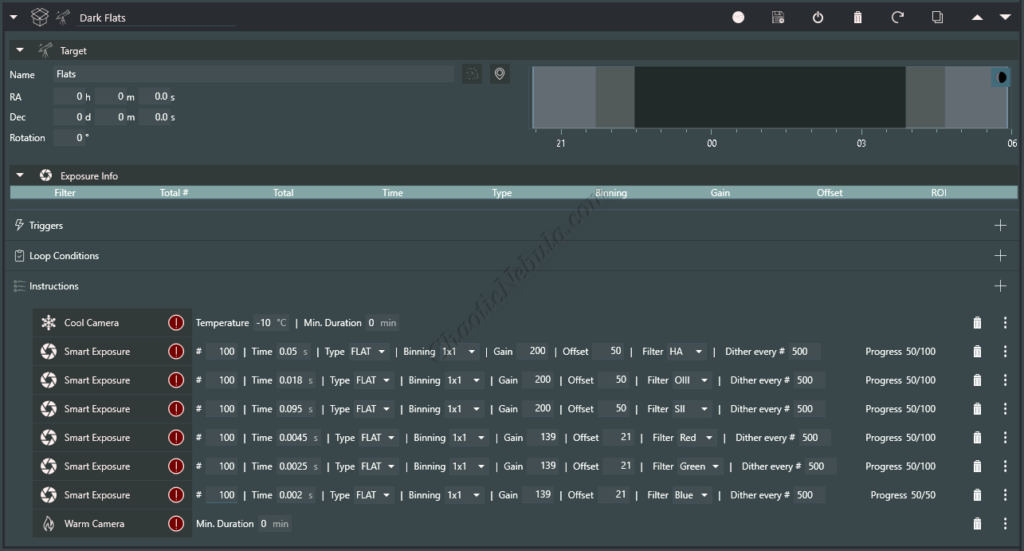
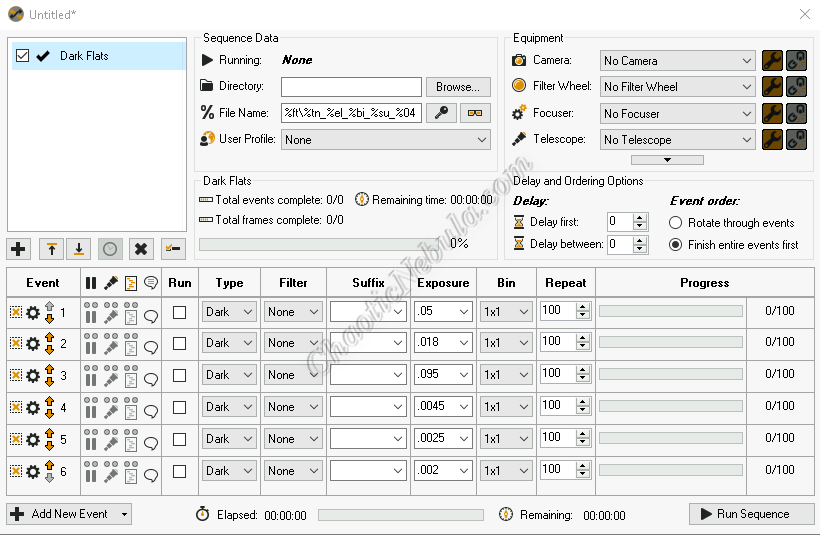
Processing
Dark Flat Frames
Once the 100-200 dark flat frames are captured, they need to get integrated into a single master dark flat frame image. Within PixInsight, this can be automated by using the Weighted Batch Preprocessing Script or manually. Details on the automated approach are found in the following guide.
For manual integration, the PixInsight Image Integration process (Process – Image Integration – Image Integration) is used.
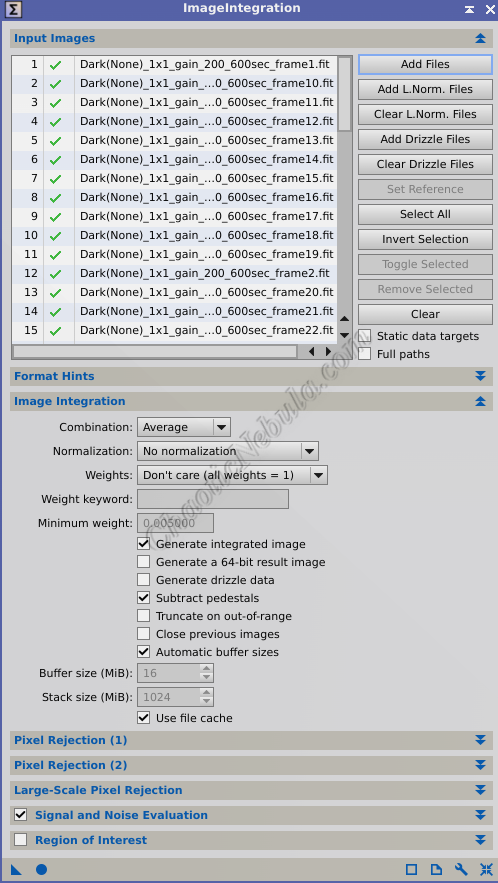
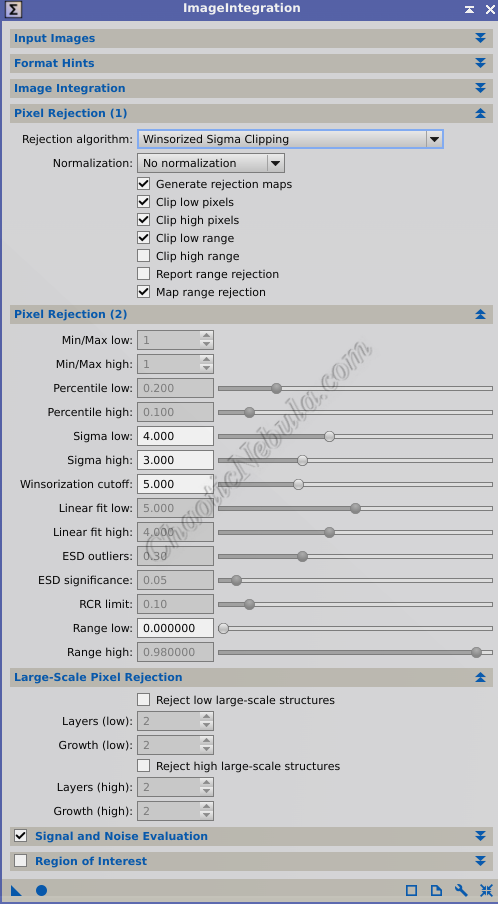
The settings to use to create a master dark flat frame are as follows:
- Image Integration
- Combination: Average. Averaging multiple dark flat frames helps to smooth out random noise present in each individual frame.
- Normalization: No normalization. Normalizing the data would alter the noise characteristics dark flat frames are trying to capture.
- Weights: Don’t care (all weights = 1). By treating each frame equally, the final master dark flat frame is less susceptible to the influence of outliers or anomalies present in individual frames
- Generate integrated image: Enabled
- Pixel Rejection (1)
- Rejection Algorithm: Winsorized Sigma Clipping. It is the optimal rejection algorithm for large sets of images.
- Normalization: No normalization
- Clip low pixels: Enabled. Helps mitigate the influence of extreme values in the darker pixels.
- Clip high pixels: Enabled. Helps mitigate the influence of extreme values in the brighter pixels.
- Sigma low: 4.00. Any pixel value more than 4 standard deviations below the mean will be considered outliers and potentially clipped
- Sigma high: 3.00. Any pixel value more than 3 standard deviations above the mean will be considered outliers and potentially clipped
- Winsorized cutoff: 5.00. Establishes percent limits on how many pixels can be cut at the low and high end. A cutoff of 5% would indicate that the lowest and highest 5% of values in the dataset will be replaced with values at the 5th and 95th percentiles, respectively.
This process creates a master dark flat frame.
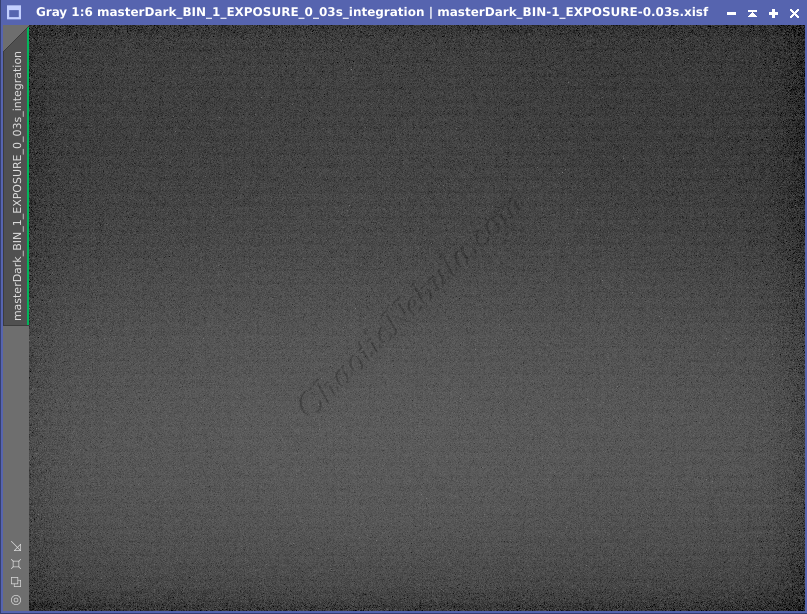
What’s Next
With a master bias calibration frame created, image processing can continue based on the respective workflow: